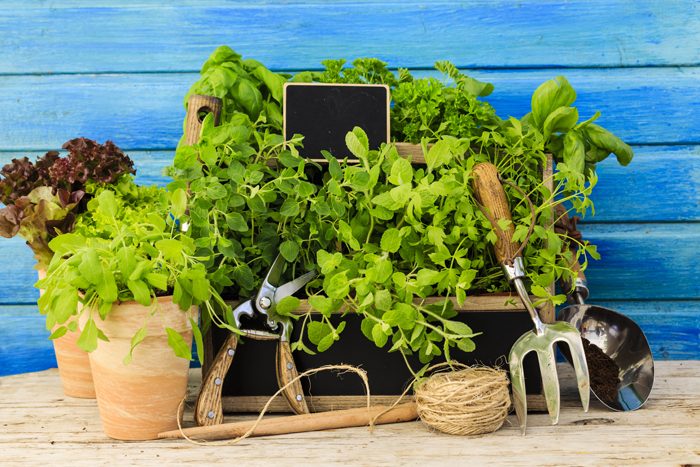
Green thumb success is totally achievable, but you need to do a little homework before you get your hands dirty.
“People realize very quickly after moving to Central Florida that this environment can be pretty difficult to have a landscape or garden in,” says Jack LeCroy, Florida-Friendly Landscape agent with UF/IFAS Extension Marion County in the Ocala office.
“Our soil, climate and hydrology issues can be very challenging. Sandy soils do not hold water and nutrients well, and the climate can be challenging, especially with regards to rain. We need to know when our rainy season is, which is in the summer, how to acclimate our irrigation systems accordingly, and we need to be very careful with what we apply to our landscapes and gardens because of the sensitive aquifer right below our feet,” he explains.
“It’s not as simple as just putting a plant in the ground or turning the irrigation system on. You can have a low maintenance garden or landscape, but it cannot be one without any maintenance,” says LeCroy. “Simply planting a tree or shrub too deep can already start your plants off on the wrong foot. These are all things that we can help with at the UF/IFAS Extension.”
“Many Florida gardeners are new to the challenges of Florida living with new bugs, new diseases and certainly new plants,” observes BJ Jarvis, director and horticulture agent with UF/Citrus Cooperative Extension in the Lecanto office.
In many cases, you can’t rely on seed packet information for optimal Florida planting. Some packets give the same planting time recommendations for the entire state of Florida as for South Carolina and even parts of Virginia—and our weather and soil systems can be vastly different.
Jarvis finds that many Florida gardeners end up frustrated because they make two common errors: poor choice of plants and not watering correctly.
“One of the most common ways that gardeners set themselves up for failure is not selecting a plant based on its preferred site conditions. If a great plant is placed in a location that is not well-suited to its needs, the plant will become stressed. This attracts pests, may encourage disease and generally causes poor performance.
“Many plants in the retail trade are not hardy here. Either they are frost-sensitive and should be grown farther south or they suffer in our intensive heat and humidity,” she explains. “Try to get to know your plants before purchasing. I suggest getting a list of plants together for each spot so that when you go to the garden center if they are out of one, they might have other choices.”
Watering plants is hardly a one-size-fits-all proposition and having an automated irrigation system won’t solve all your problems.
“Plants need different amounts of water during the growing season, versus dormancy from December through about March,” Jarvis points out. “In the winter, even when rainfall is not plentiful, plants are growing slowly and need watering about every other week. This not only saves water and money, it also protects plants from disease and other stresses.”
Jarvis finds that many homeowners are reluctant to adjust their automated watering system, but adjustment is important, both to meet plants’ needs and conserve water. (If you’ve misplaced the instruction manual for your irrigation system, you can search online or call the manufacturer’s toll-free number.)

Drought Tolerance
“Droughts in Florida are a matter of when, not if. Those of us concerned about protecting our precious water supply, while maintaining a beautiful garden should be choosing drought-tolerant plants,” says Jarvis. “This philosophy doesn’t have to preclude a thirsty rose or other water guzzlers—just keep their numbers to a minimum.”
LeCroy mentions that it’s important to differentiate between the terms “drought resistant” and “drought tolerant.”
“Not many plants we use in our landscape are completely resistant to drought. Some plants just tolerate drought more than others,” he notes. “In the Florida-Friendly Landscaping program, we have plants that are shown to be more drought tolerant than others, and we like to incorporate more of those into the landscape. Even though we get about 52 inches of rain a year, it is not divided equally throughout the year, and we have been prone to some serious droughts in past years.”
Drought-tolerant plants are more “forgiving,” especially if you don’t have an irrigation system. Jarvis finds that most gardeners don’t realize that the majority of our shrubs and trees don’t require any irrigation after they become established in the landscape.
“There is a whole host of drought-tolerant plants, so I often recommend choices that have additional benefits, such as attracting pollinators or birds or have a beautiful flower,” adds Jarvis. “One rock-solid shrub is firebush (Hamelia), which has both standard and dwarf types. It has a long period of yellow-orange tubular blooms that attract hummingbirds, a bit of fall color and blue-black berries that attract the birds in winter.”
Other drought-tolerant shrubs that also thrive in our area are hollies, glossy abelia and oakleaf hydrangea. (An added bonus is that these also do well when rainfall is plentiful.)
“One of my other favorites for color in the garden is angelonia,” recommends Jarvis. “This short perennial comes in white, lavender, deep purple and pink and blooms for about 11 months of the year. It is a good edging plant, works well in containers and brightens up a semi-shady corner.”
Gardening Trends
“Gardeners are taking sustainability and the local movement to new heights this year. Especially popular is gardening for food,” says Jarvis. “No longer are most urbanites creating a large rectangular vegetable garden ‘out back.’ Today, anything edible is grown in containers with colorful annuals and perennials. Tabletop gardens are popular, even mixing edibles such as herbs into front-yard garden beds.”
“Parsley, for example, makes an amazing border edge, which is ready for harvest at mealtime. Herbs are also super popular as an indoor or porch plant, growing in a really bright location or with the aid of a decorative, yet functional, light. This is especially helpful for those who have little to no in-ground garden space or those with limited mobility.”
“More and more people are getting into edible landscaping,” adds LeCroy. “This could be vegetables and fruits added into the landscape or just herbs put in different areas of the landscape.”
LeCroy likes to incorporate plants that have secondary uses as well, such as those that provide food or shelter for wildlife or have another benefit besides aesthetics.
“A good example is lemongrass (Cymbopogon citratrus). This grass can have the ornamental grass feature in our landscape, but you can also cook with it or make a great tasting lemongrass tea,” says LeCroy.
Go Native
According to Florida statute 5B-40.00, a native plant species is one that “is presumed to have been present in Florida before European contact.” One big plus of using native plants is to provide birds, pollinators and other critters with food sources that are a part of their normal diet.
“The population for the state of Florida is only increasing. The native areas of the state that have kept their original identities are being threatened,” notes LeCroy. “Native plants are a great tool to teach new homeowners about the beautiful native flora that we have here in Florida and are working to preserve.”
That doesn’t mean, however, that you can just buy native plants, plop them in the dirt and expect them to thrive.
As LeCroy explains, native plants have been here a long time and have proven themselves in this environment, but that environment is often significantly altered. For example, when you remove native topsoil and change the water pattern by installing irrigation, this can affect how well a native plant does.
In addition, homeowners often mingle native and non-native and/or exotic plants, which can expose the native plants to pests and disease problems they haven’t been associated with previously. This just means you still need to do your homework about proper planting and care, even when using reliable native species.
Get Growing
The good news is that you don’t have to be a pro to have a green thumb. You just have to be willing to learn.
“Plants selected for aesthetics, color and possible food production can be accomplished in most any landscape with a little homework and the assistance of local knowledgeable Extension professionals,” says Jarvis.
FYI, Extension horticulturists and trained Master Gardeners can help identify plant needs based on site conditions and make recommendations. These green thumb pros are usually happy to speak at homeowner association meetings or club events, so reach out and invite them!
Make Your Yard Florida Friendly
Follow these nine principles from the University of Florida/IFAS Extension to make your Florida yard thrive.
Put the right plants in the right places.Choose plants that match each site’s soil, light, water and climatic conditions. Group plants with similar water needs. (Extension professionals and websites have numerous plant lists that fit many conditions, so feel free to call your local office and they can help you pick plants that fit your specific site.)
Water efficiently. Water early in the morning. If you have an automated irrigation system, calibrate it for maximum efficiency. Watch the weather; don’t water if it’s going to rain.
Fertilize appropriately. Select fertilizers with slow-release nitrogen and little or no phosphorous. Use UF/IFAS-recommended rates and application timings to prevent fertilizer leaking down through the soil rather than being absorbed by plant roots. Don’t fertilizer before a heavy rain and never fertilize within 10 feet of any body of water.
Mulch wisely. A 2- to 3-inch layer of mulch helps the soil retain moisture and inhibits weed growth, but leave a gap of at least two inches around tree trunks to prevent rot and fungal infection.
Invite wildlife. Provide food, water and shelter that welcome birds, butterflies, bats and beneficial insects, which help pollinate plants. Select plants that offer seeds, fruits, foliage, berries and flowers that animals can eat, and provide a water source, such as a bird bath.
Manage pests responsibly. Use as few chemicals as possible. If insecticides are necessary to control pests, spot treat only affected areas and use selective insecticides (not broad spectrum) to address your specific pest concern.
Recycle yard waste. Don’t haul grass clippings, leaves and branches to the landfill. Compost them instead, and once decomposed, add them back to your soil to make it richer and more fertile.
Reduce runoff. Use landscaping techniques (berms, swales) to slow runoff from rain. Use permeable walkways and driveways whenever possible.
Protect water bodies. What happens in your yard doesn’t necessarily stay in your yard. Protect water bodies by maintaining at least a 10-foot maintenance-free zone around them, meaning no mowing, fertilizing or pesticide use in these areas. Keep grass clippings and pet waste out of water as well.
To learn more about using these principles in your own yard, download a copy of The Florida Yards & Neighborhoods Handbook at ifas.ufl.edu or call (352) 273-4518 to request a copy.
Florida-Friendly Favorites
Jack LeCroy, Florida-Friendly Landscape Agent with UF/IFAS Extension Marion County, counts the following as some of his favorite plants. (Remember, know your specific site conditions before choosing any plant and adding it to your landscape.)
Star anise (Illicium species): Very tolerant, fragrant leaves
Saucer magnolia (Magnolia x soulangiana): Beautiful spring flowers
Sweet almond bush (Aloysia virgate): Very fragrant flowers
Firebush (Hamlelia patens): Attracts wildlife
Fakahatchee grass (Tripsacum dactyloides): Looks good year around
For more information on plant choices, try the online query tool at floridayards.org. The bottom left quadrant is the simple search engine with hundreds of plant choices.
Learn More:
http://solutionsforyourlife.ufl.edu/ lawn_and_garden/calendar/
https://fyn.ifas.ufl.edu/plants
dis.ifas.ufl.edu/ep450
floridayards.org
davesgarden.com
garden.bsewall.com






